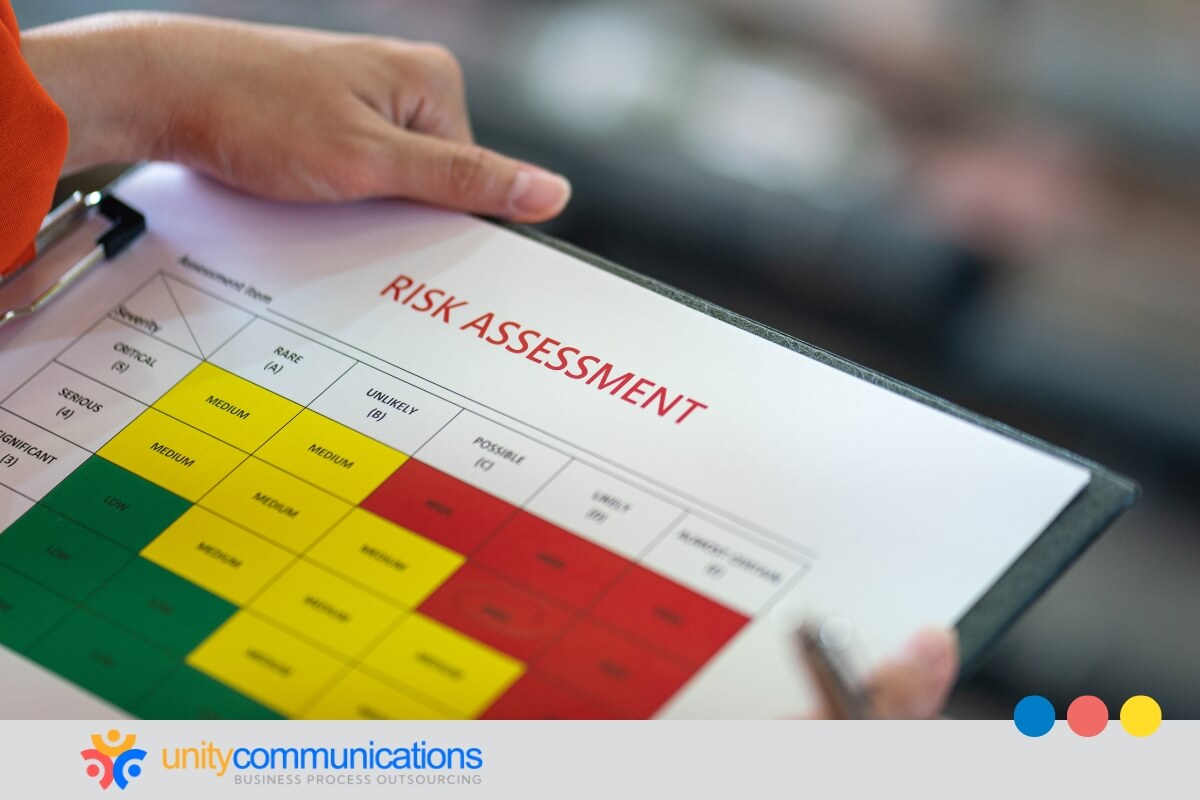Table of Contents
In today’s fast-paced, interconnected world, business process outsourcing (BPO) organizations face numerous unforeseen challenges that can disrupt operations. Robust BPO business continuity planning (BCP) is essential to mitigate these risks.
This proactive approach safeguards operations and instills a sense of security and preparedness, giving clients and stakeholders peace of mind during unexpected events.
Keep reading to gain insights into the importance of this strategy, the steps in building and implementing an effective business continuity plan, and the common issues and solutions it presents.
Understanding the importance of BPO business continuity planning

What is BPO business continuity planning? How does it benefit service providers and clients? BCP is a method for guaranteeing that third-party vendors can continue to operate and manage outsourced services even during unforeseen events.
Whether companies face natural disasters, such as earthquakes or floods, cyberattacks, or other crises that seriously disrupt business functions, BCP promotes continuous operations while minimizing downtime and protecting their reputation and customer relationships.
A well-organized BCP includes risk assessment, business impact analysis (BIA), and recovery strategy building. By recognizing potential threats and planning for them, BPO providers can protect their critical functions, sustain service levels, and remain reliable in the face of interruptions.
The advantages of BPO business continuity planning
Developing and maintaining a BCP strategy offers the following benefits:
- Enhanced dependability. BCP ensures that outsourcing organizations can continue to operate during unexpected circumstances. This reliability maintains client confidence and fulfillment.
- Better risk management. Recognizing potential threats and assessing their impact helps business process outsourcing companies manage risks, limit vulnerabilities, and prepare for emergencies.
- Greater resilience. Service providers with a BCP strategy can recover quickly from disruptions. This adaptability sustains service delivery and reduces downtime.
- Improved client relationships. BPO partners reassure their clients about their dependability by dedicating time and resources to business continuity. This proactive approach boosts customer confidence and fosters loyalty.
- Cost-effective functions. Investing in BCP can result in long-term cost benefits by decreasing the disruption’s financial effect. Effective planning helps prevent expensive interruptions and recovery costs.
- Regulation compliance. Many sectors require specialized business continuity standards. A solid BCP ensures that BPO vendors remain compliant and avoid legal and financial fines.
Building a BPO business continuity plan for unexpected events

An excellent BPO business continuity plan is critical to protecting company operations and retaining consumer confidence. Develop and execute it well with these tips:
Conduct risk assessment
The first step in BCP development is a thorough risk assessment. This involves identifying potential hazards that might interrupt business operations. Understanding these risks helps BPO firms implement targeted mitigation strategies.
Analyze the risks of your BPO business continuity planning by following these pointers:
- Identify possible dangers. Define all hazards that might disrupt operations, such as natural disasters, power outages, political instability, and cyberattacks. List all of them.
- Analyze the risk impact. Assess how each risk can affect the business process, financial stability, and client relationships. Prioritize dangers according to their intensity and probability.
- Determine vulnerability. Identify flaws in your systems and processes, such as out-of-date technology, a lack of redundancy, or inadequate security. Use the insights to create mitigating solutions.
- Review and update plans regularly. Risk evaluation must be continuous. Regularly update your BCP to reflect new threats and developments, ensuring it remains current and relevant.
Perform BIA
A vital part of BPO business continuity planning, BIA helps determine the impact of disruptions on the company’s processes. Deciding which procedures are crucial to operations allows BPO organizations to focus on protecting them.
Follow these tips when performing BIA:
- Pinpoint critical business functions. Determine all essential business functions, such as core processes that directly contribute to service delivery and client satisfaction.
- Assess dependencies and interdependencies. Analyze the relationship among these functions to prioritize recovery efforts and allocate resources effectively based on potential impacts across the organization.
- Calculate prospective losses. Assess the possible financial, operational, and reputational consequences of disrupting core business functions. Quantifying these losses helps you better understand their influence on the organization.
- Set recovery time objectives (RTO). Specify RTOs for each critical business function. RTOs describe the maximum allowable downtime before activities resume to avoid serious consequences.
Develop recovery strategies
After assessing risks and their impacts, design disaster recovery plans outlining responses to interruptions. These can be relocating operations to a backup site, enabling remote work for team members during natural disasters or economic disruptions, or implementing a data recovery plan in case of a cyberattack.
Other recovery strategies for solid BPO business continuity planning include the following:
- Build incident response teams. Establish a core group responsible for executing recovery plans. Assign specific roles to ensure a coordinated and efficient response during a disruption.
- Identify alternative workplaces. Choose and prepare sites where business operations can continue if the primary location becomes unusable. Equip these places with the necessary resources.
- Monitor and analyze incidents. Implement processes to investigate incidents as they occur. Use the data to refine recovery strategies and the BCP.
Generate a business continuity plan template
A BCP template provides consistency and comprehensiveness. It guides documentation and covers emergency response procedures and communication protocols. Standardizing the process addresses all critical elements.
Use these recommendations to generate a template for BPO business continuity planning:
- Specify objectives. Clarify the plan’s targets, such as reducing downtime, protecting essential functions, and speeding up recovery from disruptions.
- Identify essential components. List all the critical components that the BCP must cover. These include risk assessments, BIA, recovery plans, emergency response processes, communication protocols, and plan maintenance. Offer guidelines for documenting each section.
- Establish communication protocols. Develop internal and external communication strategies for timely and accurate information transmission during a crisis.
- Outline emergency response processes. Describe efforts to ensure safety and reduce damage, such as evacuation plans and first-aid procedures.
Implement a backup plan
A robust backup plan is crucial in BPO business continuity planning. It usually involves the following strategies:
- Set backup procedures. Strive to keep critical data available during disruptions. Specify the frequency of backups (daily, weekly, etc.) to maintain business activities and minimize data loss. Set up redundancies to decrease downtime in case of a primary system failure.
- Select backup locations. Choose secure off-site or cloud-based backup locations to safeguard data from physical disruptions at your primary site.
- Review and update the backup plan. Regularly check and update your backup strategy to reflect business changes and emerging risks.
Launch training and awareness programs
All team members must understand and practice an effective business continuity plan through regular training and awareness initiatives. The preparation minimizes confusion and enables a swift, coordinated response during emergencies.
Consider these suggestions to help launch efficient training and awareness for BPO business continuity planning:
- Develop training modules. Design structured training modules covering vital BCP aspects, such as risk assessment, emergency response procedures, and roles or responsibilities during disruptions.
- Tailor content to roles. Customize training content based on team members’ roles to inform them on how their actions contribute to business resilience.
- Schedule regular training sessions. All team members must receive consistent updates and remain prepared for emergencies.
- Include simulation exercises. Incorporate simulation exercises to familiarize team members with BCP procedures and enhance response times during actual emergencies.
- Diversify training methods. Launch workshops, seminars, and online modules to accommodate different learning styles and preferences.
Test and update the plan
Testing and updating the plan is also a BCP requirement. Conducting drills and simulations identifies its weaknesses and areas for improvement. Regularly review and update the BCP account regarding business changes, new threats, and lessons from past incidents.
Take this advice when testing and updating the BPO business continuity planning:
- Schedule regular drills and simulations. Simulations should replicate potential disruptions to identify weaknesses and improve response strategies.
- Gather feedback and evaluate performance. Collect participant input after each drill or simulation. Evaluate performance against predefined objectives and identify areas for improvement in the BCP.
- Review incident response. Analyze actual incidents and responses to identify gaps or inefficiencies in the BCP. Incorporate lessons learned to refine procedures and enhance preparedness.
- Conduct tabletop exercises. Organize exercises with essential stakeholders to simulate crises and assess decision-making processes. Use these simulations to validate BCP effectiveness and teamwork.
BPO business continuity planning: Common issues and solutions

Despite their best efforts, BPO firms might encounter several issues when developing and implementing their BCPs. Here are the key challenges and how to address them:
- Insufficient senior management support. Obtaining senior management buy-in is crucial to secure resources for developing and maintaining an effective BCP.
Recommended solutions: Communicate the value of BCP in terms of risk management and long-term cost savings. Demonstrate how a robust plan can protect the company’s reputation and how client relationships can help garner the needed support.
- Inadequate risk assessment. Another common issue is an incomplete risk assessment, which can lead to gaps in the BCP.
Recommended solutions: Ensure thorough risk assessment of natural disasters, cyber threats, and other hazards. Engage external experts for additional insights on potential overlooked risks.
- Insufficient communication. Effective communication is vital for the success of a BCP. Unclear communication can result in confusion and delays during an emergency.
Recommended solutions: Detail communication protocols, assign responsibilities, and specify dissemination methods. Regularly test these protocols through drills to ensure they function smoothly when needed.
- Outdated plans. A common pitfall is failing to keep the BCP up to date. As business operations, technologies, and external threats evolve, the BCP should adapt accordingly.
Recommended solutions: Schedule a regular review and assign responsibility for updates to keep the plan relevant and practical.
- Neglected business functions. Though not critical individually, smaller business functions collectively affect overall operations and should not be ignored.
Recommended solutions: Develop a comprehensive business continuity plan to address all aspects of the business process, including minor functions.
The bottom line
In competitive outsourcing environments, maintaining continuous operations amid unexpected events is crucial. BCP identifies threats, assesses impacts, and mitigates risks, enhancing resilience and service continuity.
Addressing common challenges is crucial for a successful BCP. It is necessary — and not just a best practice — to safeguard operations, protect their clients, and ensure longevity in today’s unpredictable business landscape.
Let’s connect to learn more about BPO business continuity planning and how Unity Communications can help your organization become more resilient.




